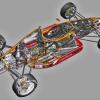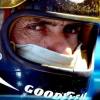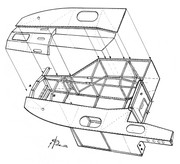I have been making notes about Ferrari chassis design philosophy since it was raised in a thread several years ago. It is as clear as mud to me, so be gentle in response to my mistakes.
The Hans Tanner/Doug Nye Ferrari book and Doug's History of the Grand Prix Car 1966-1985 tell the same story about the Ferrari 312T and T2. The 312T was a logical development of the 312B3 but a clean sheet design, obviously, owing to the transverse gearbox and revised rear suspension. The main difference is at the front where a matrix of tubes on the 312B3 is replaced by a more elegant structure. The front suspension hangs off a magnesium casting with short levers and rockers actuating the springs and anti-rollbar. Development of the 312T began in 1974 and continued into the 1976 season. Chassis numbers overlap with the 312B3, so the first two are #018 and #021.
Nye, History of GP Car, describes the inner framework as steel "strip and angle" in the body text. A caption for a Tony Matthews cutaway describes a "square section" inner frame.
The 312T2 is less of a clean sheet design but it was intended to address regulation changes in 1976. Sadly it was never fully developed and was unable to maximise that year's Goodyear tyres.
Journalists give a consistent record of the first appearances of the 312T2:
#025 -- press display in autumn 1975 with first track event at Race of Champions, 1976.
#026 -- Spanish GP, 1976.
#027 -- Monaco GP, 1976.
#028 -- British GP, 1976.
#029/030/031 -- all raced in 1977 alongside earlier cars.
#025 re-introduced the idea of De Dion rear suspension -- in testing at least. The front bulkhead and suspension design was very similar to the 312T but the car dimensions changed. Overall car weight was reduced by 20+ kg. Tanner/Nye Ferrari book states "aluminium U-piece internal framing replaced the steel reinforcement of its Maranello-built predecessors". In the History of GP Car, Nye writes about an aluminium tube frame "while a true monocoque version was on the way".
For #026, the Tanner/Nye Ferrari book says that there was no U-piece internal frame. #027 and #028 are also described as pure monocoques.
In the Autocar race report for the 1976 Belgian GP, Peter Windsor describes #026 as a pure monocoque. He explicitly states that the U-pieces of the original chassis are absent. Windsor added that strikes at the factory had delayed build of a third 312T2 chassis. [Nye and Windsor both use the unusual description "U-piece".]
#028 was the car in which Lauda crashed at the Nurburgring, which was a pure monocoque according to British descriptions.


























